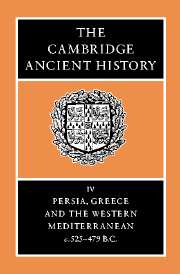Book contents
- Frontmatter
- Contents
- List of maps
- List of text-figures
- List of chronological tables
- Preface
- PART I THE PERSIAN EMPIRE
- 1 The early history of the Medes and the Persians and the Achaemenid empire to the death of Cambyses
- 2 The consolidation of the empire and its limits of growth under Darius and Xerxes
- 3 The major regions of the empire
- 3a Babylonia from Cyrus to Xerxes
- 3b Syria-Palestine under Achaemenid rule
- 3c Central Asia and Eastern Iran
- 3d The Indus Lands
- 3e Anatolia
- 3f Persia in Europe, apart from Greece
- 3g Egypt 525–404 B.C.
- PART II THE GREEK STATES
- PART III THE WEST
- BIBLIOGRAPHY
- Index
- Map 1. The Achaemenid empire
- Map 6. Central Asia
- Map 9. The Black Sea area
- Map 11. Egypt
- Map 13. Greek and Phoenician trade in the period of the Persian Wars
- Map 15. Greece and the Aegean
- Map 18. Northern and Central Italy
- Map 19. Central and Southern Italy
- References
3d - The Indus Lands
from 3 - The major regions of the empire
Published online by Cambridge University Press: 28 March 2008
- Frontmatter
- Contents
- List of maps
- List of text-figures
- List of chronological tables
- Preface
- PART I THE PERSIAN EMPIRE
- 1 The early history of the Medes and the Persians and the Achaemenid empire to the death of Cambyses
- 2 The consolidation of the empire and its limits of growth under Darius and Xerxes
- 3 The major regions of the empire
- 3a Babylonia from Cyrus to Xerxes
- 3b Syria-Palestine under Achaemenid rule
- 3c Central Asia and Eastern Iran
- 3d The Indus Lands
- 3e Anatolia
- 3f Persia in Europe, apart from Greece
- 3g Egypt 525–404 B.C.
- PART II THE GREEK STATES
- PART III THE WEST
- BIBLIOGRAPHY
- Index
- Map 1. The Achaemenid empire
- Map 6. Central Asia
- Map 9. The Black Sea area
- Map 11. Egypt
- Map 13. Greek and Phoenician trade in the period of the Persian Wars
- Map 15. Greece and the Aegean
- Map 18. Northern and Central Italy
- Map 19. Central and Southern Italy
- References
Summary
During the sixth century B.C., northern India was divided between a number of local republics and kingdoms, traditionally reckoned as sixteen. Along the Ganges lay the four states most centrally placed, which at first had competed among themselves for dominance. To the north west, above the sacred river, was Kośala, with its cities of Śrāvastī, and Sāketa/Ayodhyā. South of the river, and towards the east, lay Magadha, centring around RājagṔha (Rajgir) and later PāṬaliputra (now Patna). To the south west was Kāśī, the country of Vārānasī (Benares). To the north east lay Vṛji, with the capital at Vaiśālī, the modern Besarh. Though in earlier times Kāśī, and later Kośala had enjoyed brief preeminence, it was finally Magadha which was to emerge as the paramount power, and impose a unitary administration on the sub-continent.
More outlying janapadas (as these regional states are designated in Indian literature, on some coins, and in current historical writing) were, towards Bengal, the state of AṄga; upstream, along the River Yamunā (or Jumna) lay Vatsa, with its capital Kauśāmbī, in recent years the site of excavations; and beyond, again, was Śūrasena, centred round Mathurā. In present-day Malwa lay Avanti, with its centre at Ujjayinī (Ujjain). This in turn was flanked to the east by CeḌi in Central India, and to the north west by Matsya with its capital at Virāta (Bairat) in present Rajasthan. Further to the north lay Pañcāla on the upper Ganges, and the region of the Kurus on the upper Jumna around Indraprastha (now Delhi).
- Type
- Chapter
- Information
- The Cambridge Ancient History , pp. 194 - 210Publisher: Cambridge University PressPrint publication year: 1988
References
- 1
- Cited by



